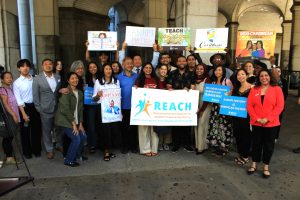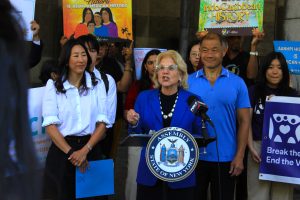
Asian American Leaders Push Hochul to Sign Education Equity Bill
MOHAMED FARGHALY
mfarghaly@queensledger.com
As students across New York prepare to return to classrooms this week, Asian American leaders and advocates gathered on August 27 at the steps of Tweed Courthouse in Manhattan to celebrate the passage of the AANHPI Education Equity Act and call on Gov. Kathy Hochul to sign it into law.
The measure, approved by both chambers of the state legislature in June, would require the New York State Education Commissioner to conduct a statewide survey of school districts to determine how Asian American, Native Hawaiian and Pacific Islander (AANHPI) history is being taught. It also establishes the first-ever AANHPI History Advisory Committee to provide recommendations for integrating that history more fully into classrooms.
“This is a good step forward towards getting that curriculum passed in the state,” said Felicia Singh, director of policy and government relations at the Coalition for Asian American Children and Families (CACF). “It is hopefully going to get us the data we need to best inform our advocacy for curriculum, inclusive curriculum in schools. And we just really hope that the governor is going to sign it before the year ends.”
The R.E.A.C.H. Coalition — short for Representing and Empowering AANHPI Community History — organized Wednesday’s rally and press conference, joined by State Sen. John Liu, Assemblymember Grace Lee, educators, students and community leaders. Speakers framed the bill as a milestone for education equity, stressing the need for AANHPI students to see themselves reflected in classrooms and for all students to learn a fuller picture of American history.
Singh said the survey will provide “data informed policy, because the findings will provide the state with a clear picture of where curriculum gaps exist and how to address them effectively.” She added that the results would also help determine “what kinds of supports for teachers and schools are needed and where resources are lacking.”
Currently, advocates say New York classrooms often present AANHPI history narrowly, focusing on limited time periods such as the arrival of Chinese immigrants in the 19th century or Japanese incarceration during World War II, while leaving out many other communities and contributions. Singh pointed to the absence of Indo-Caribbean history as an example of how entire groups remain excluded.
“For example, Indo-Caribbean history is missing from the way we teach history in schools,” she said. “Indentured servitude was an important point in history after the emancipation of slavery that is not widely taught in schools, and I think it’s adding to a continuing history by integrating different communities’ histories within how we teach American history in particular.”

Advocates envision a curriculum where AANHPI histories are not taught in isolated lessons but are equitably integrated into how American history is taught overall. They argue that doing so would help combat stereotypes, expand cultural understanding and ensure that AANHPI students feel seen and represented.
The R.E.A.C.H. Coalition has been pressing for more than three years for an AANHPI curriculum in New York schools. Singh credited students, teachers and community organizations for building momentum. “Because of the momentum driven by community-based organizations, students, youth, community advocates, it made the Department of State, and the Chancellor Betty Rosa see and understand that this is an urgent need for the community,” she said.
“As our kids head back to school, we must ensure that what they learn reflects the true history of New York’s diverse AANHPI communities, which have shaped our state and nation for generations,” said State Senator John Liu, Chair of the Senate NYC Education Committee. “For too long, these stories have been absent from our classroom either by design or willful ignorance. This legislation ensures we take a clear-eyed look at what is being taught, and what’s not, so that all students can benefit from a more honest and complete understanding of our shared history.”
Singh acknowledged challenges in expanding curriculum. “I think the challenge is just getting curriculum in schools in general, no matter what the curriculum is, especially like race based or ethnic based curriculum, I think is the hardest, hardest fight,” she said. “There are a lot of different kinds of parameters. It’s like, how do we do it? What resources do we need? Do we have support from the state of education, the New York State Education Department, New York City DOE?.”
The AANHPI Education Equity Act is considered the first step in a multi-year approach. A related measure, S3334/A4638, would go further by creating an AANHPI curriculum aligned with state learning standards, though it has not yet advanced.
“Education is under attack in this country from the Trump administration and the far right. It is imperative that we strengthen and protect quality education here in New York State and include the histories of Asian Americans, Native Hawaiians, and Pacific Islanders in public education now. When our education reflects the rich histories and diverse contributions of the people in our state and beyond, we prepare our students to become stronger leaders. That is why the AANHPI Education Equity Bill must be signed without delay,” said Assembly Member Jessica González-Rojas.
If Hochul signs the bill, Singh said the coalition’s next priority will be ensuring that members of the advisory committee have strong backgrounds in teaching and AANHPI history. “Essentially, trying to see if we can nominate folks to the advisory committee or be able to be in close relationship with those who are appointed,” she said.
For Singh, the legislation marks progress after years of advocacy. “It’s also a tool too—it’s a multi process to get us to a place of getting AANHPI curriculum in schools across the state,” she said.



